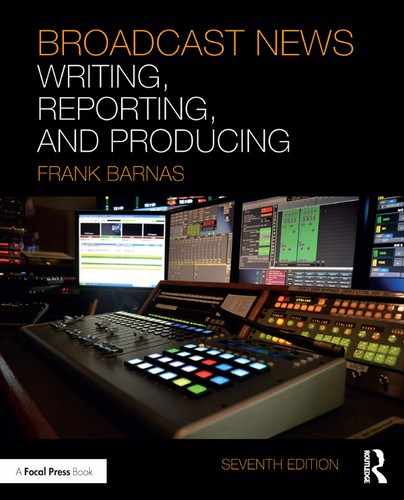ACKNOWLEDGMENTS
INTRODUCTION
Part 1 Acquiring the News
Chapter 1 Legal and Ethical Considerations
Introduction
Accuracy
Gathering News and Getting Information
Protecting and Defending Your Work
Knowing the Legal Ramifications
Knowing the Ethical Ramifications
Online Ramifications
Summary
Test Your Knowledge
Exercises
Chapter 2 Locating the News
Introduction
Assignment Desk
Spontaneous, Planned, and Enterprised Stories
Follow-Ups on Previous Newscasts
The Wires
Local Experts
Social Media and the Internet
Monitoring the Competition
Beat Checks, Cop Shops, and Police Scanners
Press Releases and Future Files
Franking and Political News Releases
Public Information Officers
The Calendar
Production Meetings
Summary
Test Your Knowledge
Exercises
Chapter 3 Developing Stories
Introduction
Advancing the Story
Avoiding the Pack
Localization
Tips
Confidentiality
Accuracy of Sources
Gaining Confidence
Leaks
Trial Balloons
Authoritative or Informed Sources
Background Briefings
Keeping in Touch
Summary
Test Your Knowledge
Exercises
Chapter 4 Collecting Information from Real and Virtual Documents
Introduction
Internet Versus Physical Reporting
Internet Domains
Internet Searches
Social Media
Open Records
Public Records and “Sunshine Laws”
Filing an FOIA Request
The Privacy Act
Collecting Governmental Information
Collecting Information About the Government
Government Information on Businesses and Individuals
Additional Real and Virtual Documents
Database Services
City Directories, Phone Books, and Reverse Directories
Creating Expert Databases
Summary
Test Your Knowledge
Exercises
Chapter 5 Beats, Spot News, and Reporting Assignments
Introduction
Beats
Spot News
Summary
Test Your Knowledge
Exercises
Part 2 Writing the News
Chapter 6 Newswriting Mechanics
Introduction
Slugs
The Split Page
Punctuation
Rewriting Wire Copy
Conversational Style
Removing Unneeded Words
Reading Your Copy Out Loud
Avoiding Information Overload
Looking Ahead
Timing Stories
Summary
Test Your Knowledge
Exercises
Chapter 7 Newswriting Style
Introduction
Descriptors and Identifiers
Numbers, Capital Numbers, Punctuation Marks, and Websites
Language—Using the Best Words
Language—Using the Best Phrasing
Verbs
Attribution, Quotes, Time, Transitions, Locations, and People
Transferring to the Web and Social Media
Summary
Test Your Knowledge
Exercises
Chapter 8 Writing Compelling Leads
Introduction
The Five Ws and H Rule
The “Right” Emotion
The Eight Types of Leads
Updating the Lead
Summary
Test Your Knowledge
Exercises
Part 3 Reporting the News
Chapter 9 Fieldwork
Introduction
Equipment
Setting Up in the Field
Video
Audio
Summary
Test Your Knowledge
Exercises
Chapter 10 Interviewing
Introduction
Before the Interview
Warming Up
During the Interview
Phrasing Questions Carefully
Avoiding Leading Questions
Listening Carefully
The Tough Questions
Keeping Control
Keeping a Neutral Demeanor
Identifying Sound Bites
Checking Facts
Asking Enough Questions
Finishing the Interview
After the Interview
Returning to the Station
Special Considerations
Off the Record
Man-on-the-Street Interviews
The Phone Interview
Summary
Test Your Knowledge
Exercises
Chapter 11 Covering Planned Events
Introduction
Press Conferences
Political Press Conferences
Promotional Press Conferences
Emergency Press Conferences
Covering the Press Conference
Interviewing around the Press Conference
Finding Workable Video
Meetings
Virtual Press Conferences
Summary
Test Your Knowledge
Exercises
Chapter 12 Reporting Live
Introduction
Organizing Thoughts
Ad-Libbing
Memorizing and Delivering Live Reports
Live Shots and Streaming
Keeping Cool
Voiceovers from the Field
Technical Challenges
Summary
Test Your Knowledge
Exercises
Chapter 13 Voiceovers, Packages, and Story Formats
Introduction
Readers
Combining Words and Pictures
Voiceovers
Scripting the Voiceover
Incorporating Sound Bites
The Split Page
The Package
Stand-Ups and Reporter Involvement
Posting Stories
Summary
Test Your Knowledge
Exercises
Part 4 Producing the News
Chapter 14 Producing the Television Newscast
Introduction
Producers—Definitions and Skills
The Logistics and Strategies of Producing
Technical Aspects of Producing
Summary
Test Your Knowledge
Exercises
In-Class Exercise: Creating a Newscast
Chapter 15 Producing the Radio Newscast
Introduction
The State of Radio News
Your Audience
Organizing Material
Fundamentals of Writing for Radio News
Writing from the Back
The Lead Story
The Rest of the Newscast
Localizing the News
Story Length
Actualities and Field Technology
Studio Technology
Wraparounds
Lead-Ins
Teases
Headlines
Pad Copy
Back Timing
Convergence and Radio News
Summary
Test Your Knowledge
Exercises
Chapter 16 Delivering the News
Introduction
Appearance
Credibility
One-Way Communication
Delivery, Pacing, and Dialects
Reading the Teleprompter
Listening to Yourself
Correct Pronunciation
Marking Copy
Characteristics of Successful Anchors
Cosmetics
Before the Newscast
Mic Levels
Virtual News Sets
Online Delivery
Summary
Test Your Knowledge
Exercises
Part 5 Transitioning into Professional Newsrooms
Chapter 17 Careers in Broadcast Journalism
Introduction
Media’s Dominance in America
Employment Trends in Broadcast Journalism
Working Environment and Job Descriptions
Future Opportunities in Newsrooms
What You Will Need to Know to Land a Job
Summary
Test Your Knowledge
Exercises
Chapter 18 Portfolio Development
Introduction
Self-Assessment
Cover Letters
Resumes
Sample Reel Structure
Website Structure
Summary
Test Your Knowledge
Exercises
GLOSSARY
INDEX
